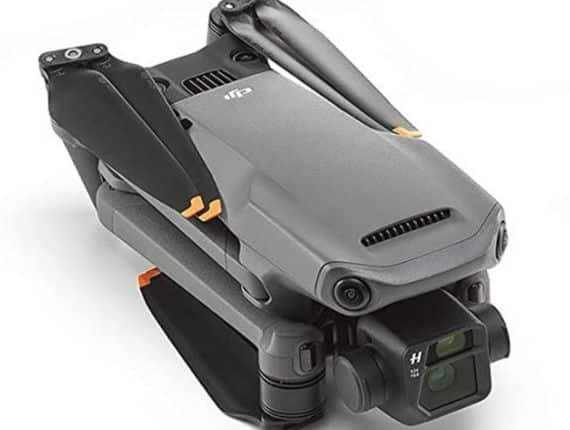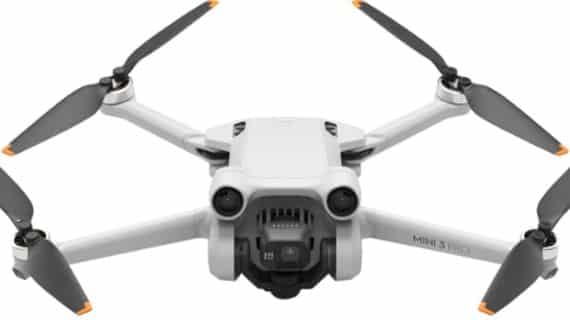Two of the most popular drones on the market today are the DJI Mavic 3 and the DJI Mini 3 Pro. Both are highly rated and come with unique features that make them suitable for different purposes. In this article, we shall compare both drones highlighting their design, camera features, and flight capabilities, to help you make an informed decision when choosing either one of these drones.
DJI Mavic 3 vs DJI Mini 3 Pro – Design
The DJI Mavic 3 and DJI Mini 3 Pro designs are quite different. The DJI Mavic 3 is a larger drone, measuring 347.5mm x 283mm x 107.7mm when unfolded and weighing 895g. It features a foldable design that makes it easy to transport and store. The weight of this drone is incredible when you realise the number of features it has and the dual camera system.
On the other hand, the DJI Mini 3 Pro is a smaller and more compact drone, measuring 171mm x 245mm x 62mm when unfolded and weighing just 249g. It is incredibly lightweight and can easily fit into your pocket or backpack.
As it weighs less than 250g, the Mini 3 Pro is not required to be registered with the FAA. However, users will still need to complete the Recreational UAS Safety Test (TRUST), which is administered by FAA-approved third-party organisations.
Both drones can be used with the DJI RC-N1 controller, which provides a comfortable and ergonomic grip, although it is a large controller compared to previous Mavic controllers.
The Mavic 3 can also be operated with the DJI RC Pro controller. It features a built-in 5.5-inch 1080p touchscreen display, which provides a clear and bright view of the live feed from the drone’s camera.
The DJI RC Pro controller operates on the DJI OcuSync 3.0+ video transmission system, which provides superior video streaming capabilities allowing pilots to stream video footage in 1080p at 60fps for high-quality and low-latency videos.
The Mavic 3 and Mini 3 Pro can also be controlled with the DJI RC controller. This also has a large 5.5-inch HD display and uses the OcuSync 3.0 (Mini 3 Pro) or 3.0+ (Mavic 3) technology for video transmission.
DJI Mavic 3 vs Mini 3 Pro – Camera
When it comes to camera quality, the DJI Mavic 3 is the clear winner. It features a Hasselblad camera with a 4/3 CMOS sensor and a 10-bit Dlog- colour profile that allows for greater dynamic range and colour grading. The camera can record videos in 5.1K at 50fps, DCI 4K at 120fps and 4K at 120fps and capture 20MP photos. Videos can be captured in Apple ProRes 422 HQ/LT and H.264/H.265. The camera also comes with an adjustable aperture, 12.8 stops of dynamic range, HNCS natural colour technology and VDAF autofocus technology.
One of the unique features of the Mavic 3 drone is that it comes with an additional zoom or telelens camera. This HD camera can also capture 12MP images and 4k video footage. However, the main feature is its 28x hybrid zoom function, allowing users to shoot and capture amazing videos and images from a distance. It also features a three-axis gimbal that ensures stable footage even in windy conditions.
In contrast, the DJI Mini 3 Pro features a 48MP camera with a 1/1.3-inch sensor that can shoot 4K video at up to 60fps and 2.7k at 60fps and has a maximum bitrate of 150mbps. One of the unique features of the Mini 3 Pro is its 3-axis gimbal which allows the camera to shoot in true vertical format. In this age where social media platforms prefer vertical videos, this is an excellent feature for social media influencers.
While the camera quality is not as high as the DJI Mavic 3, it is still impressive for a drone of its size and price range. The camera also features a D-Cinelike colour profile for HDR videos, digital zoom and multiple photography modes.
Both cameras also come with the intelligent video capturing modes Mastershots and Quickshots. This will allow anyone to record short HD videos at the push of a button.
Flight Features
Both drones have various flight features that make them easy and enjoyable to operate. The DJI Mavic 3 features a maximum flight time of 46 minutes and a maximum speed of 47 mph and has a wind resistance of 26 mph.
It also features the most advanced obstacle avoidance technology in the Mavic range; it has binocular vision sensors on the top, bottom, and sides and an infrared sensor on the bottom. An LED light on the bottom can act as an anti-collision beacon for night flying.
The drone has various intelligent modes, including ASPAS 5.0 for a safer flying experience and autonomous flight modes such as ActiveTrack, Spotlight and Point of Interest and Hyperlapse, which allows you to create time-lapse videos. It uses DJI’s latest version of its OcuSync video transmission system for a range of 15km. This will allow users to receive live video feed to their smartphone in 1080p at 60fps.
On the other hand, the DJI Mini 3 Pro features a maximum flight time of 34 minutes (although this can be extended to 47 minutes with an intelligent plus battery) and a maximum speed of 36 mph. It has a 3-way omnidirectional obstacle avoidance system; it’s not as advanced as the Mavic 3 but still helpful in avoiding obstacles along with its ASPAS 4.0 system.
Like the Mavic 3, the Mini 3 Pro uses DJI OcuSync transmission technology, the range is 12km, which is slightly shorter than the Mavic 3.
An Added bonus for those living in the USA, both drones come with FAA-approved remote ID technology, which will be a requirement for all drone pilots from September 2023.
DJI Mavic 3 Or Mini 3 Pro -Which Drone is Right for You?
Choosing between the DJI Mavic 3 and the DJI Mini 3 Pro can be challenging, as both drones offer unique features that cater to different users. To help you make an informed decision, here are some factors to consider when choosing between the two drones:
Camera Quality: If you are a professional photographer or videographer, the DJI Mavic 3 superior camera quality may be the deciding factor. Its larger image sensor, HNCS natural colour technology, secondary zoom camera, higher ISO range, and adjustable aperture provide users with more features to capture the perfect shot. However, the Mini 3 Pro has some fantastic camera features and may be the better option for people on a budget. The drone will especially appeal to people who post their images and videos on social media because of its true vertical shooting mode.
Size and Portability: If you plan on frequently travelling with your drone or want a drone that is easy to transport, the DJI Mini 3 Pro’s compact size and lightweight design make it a clear winner. However, with its foldable design and superior camera and flight features, the DJI Mavic 3 larger size may not be an issue.
Flight Features: Both drones come with various features that make them easy and enjoyable to fly, but the DJI Mavic 3 has an advanced obstacle avoidance system that may be more important if you plan on flying in crowded areas or want a drone that is safer to fly. The Mavic 3 also comes with the longest flight time of any consumer drone and comes with advanced intelligent flight modes and OcuSync 3.0+ transmission system. However, the DJI Mini 3 Pro comes with similar features but is less advanced; its flight time of 34 minutes is excellent and the best for a mini drone, and it comes with a good obstacle avoidance system.
Budget: The DJI Mavic 3 is a more expensive drone than the DJI Mini 3 Pro, so if you have a limited budget, the DJI Mini 3 Pro may be the more practical option. However, if you are willing to spend more for better camera quality and flight features, the DJI Mavic3 may be worth the investment.
Final Thoughts
In conclusion, the DJI Mavic 3 and the DJI Mini 3 Pro are impressive drones with unique features catering to different users. To determine which drone suits you, consider your needs and preferences regarding camera quality, size and portability, flight features, and budget. I recommend the Mini 3 Pro, it’s a fantastic drone with amazing features, and unless you are a professional aerial videographer, the Mavic 3 is unsuitable for the average user.



